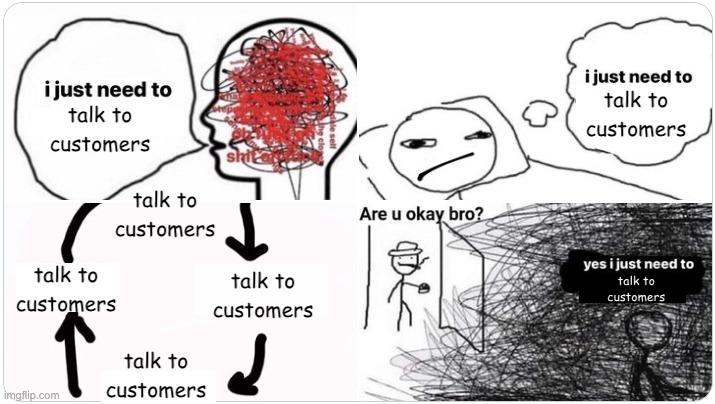Something Personal: Customer Obsession
Last year, around this time, I wrote about our marketing strategy. I feel similarly right now during the long Diwali break. My personal space has become decluttered, and I feel like writing again. I feel reflective and want to write about what’s almost always on top of my mind these days: Customers.
Customers, customers, customers. Source: Anton Osika

I am obsessed with customers. I just want to ensure they are the happiest customers of any company. Buying JOHNAIC should feel like the best decision they have ever made. They should be awed by the amount of support we give them. They should be surprised by how we are able to manage this level of engagement. They should think we are insane for providing this level of support. It should feel startling compared to how other vendors deal with their customers. I will illustrate this by giving a few concrete examples.
When a customer buys servers from well-known brands like Dell or HP, they expect high quality hardware. They do not expect much support beyond faulty hardware replacements or firmware updates. When a customer takes a risk and buys a JOHNAIC, they tend to be hesitant about longevity or quality of the hardware. After all, we’re a new player with unproven ability to deliver. They are startled by our level of support and over-engagement when we help them set up databases, ETL pipelines, high performance LLM inference engines or whatever customers bought the machines for. They are surprised by the amount of accountability we take not just on hardware failures but also critical business applications running on our hardware. They are startled by the amount of training we provide to the team to help them get started with the latest technologies like containers or AI.
This level of customer engagement seems insane to the most people (especially founders) out there. How are we going to scale this level of support as we become bigger? Aren’t the costs going to blow up? If we are obsessed with customers all the time, when are we even going to build the product? Turns out all of these are false paradoxes! Let me explain. There are sound business reasons behind this level of customer obsession.
First of all, we don’t have anything to lose by over-engaging customers at the current stage. After all, we don’t have too many customers because we are not too big right now. So our costs are the same regardless of how we work with customers. A happy customer is surely better than an unhappy customer. This dynamic might change in the future but it is surely a good idea to over-engage now – but I believe it’s unlikely to change because of reasons below.
The biggest risk of building a company is not making a ‘bad’ product but making something people do not want. It’s so much easier to sit in your corner and code up something we like but this is useless if customers are unwilling to pay for it. Truths about what customers pay for are not in your building. Sure, sales effort gives a lot of signal on what customers want but it’s not the complete signal. During a sales conversation with the customer, all the discussions are thought experiments and hypotheticals. Support is when the rubber touches the road – when we are doing the real problem solving.
Just like our manufacturing, our software development also follows ‘just-in-time’ model. We already deliver a lot of value when the customer buys hardware from us. Whatever we do on top of this feels ‘extra’ to the customer. So the customer allows us to do further product development by giving feedback, data to work on and so on. We start with solid open source systems like Ubuntu LTS, PostgreSQL and GPT-OSS and start integrating them together for the customer on understanding their business requirements. When a customer asks for support, we see it as an opportunity to add a new feature to our product. In other words, we blur the difference between customer support and product development.
Counterintuitively, spending more time with the customers also helps us with sales. This is due to two reasons. Firstly, over-engagement leads to a better product and what’s built for one customer is likely to be the same for another customer. Customers talk among themselves; they share new things they are doing with each other. This leads to word of mouth and referrals. Secondly, there is insatiable need for more compute for each customer. When customers trust us with their compute needs, they just keep on buying from us. Our largest sales came from existing customers.
Thus, customer over-engagement is simultaneously a sound marketing strategy and product development strategy. Organizational culture eats strategy for breakfast. So to back this strategy, we do a few things very differently from everyone. Our engineers are trained from day one to be good with communication along with technology. They take responsibility for talking with customers, understand their problems and deploy the solution to the customer’s servers. They are trained to be keen on customers’ needs and anticipate them before the customers ask for them. If solving for these problems requires more compute, they ask for orders for more servers.
I have not cooked up these management ideas by myself. Two sources of immense inspiration are an essay by Paul Graham called Do things that don’t scale and a book by Steve Blank called The four steps to epiphany. These two have become my management bibles.
We are going to stick with this customer over-engagement model as long as we can sustain it. I believe we can keep doing it for a very long time. Customers are already making us do greater things by asking new things of us. This is translating to tangible revenue. We are where we are now thanks to the customers. I am very grateful for the trust they have in us. I hope they take us to greater heights!